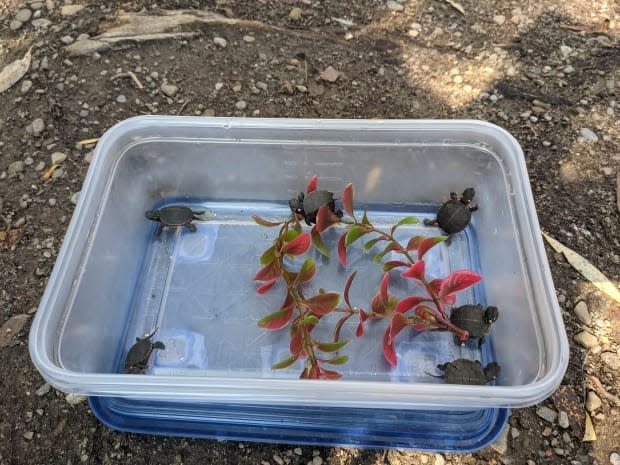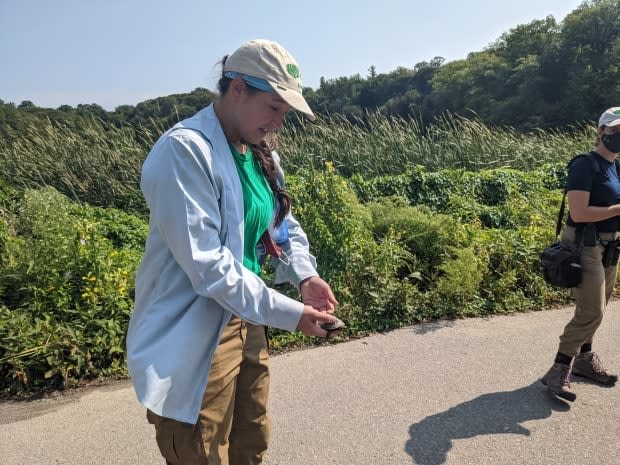6 tiny turtles released into mud of Grindstone Creek — the last from 59 nests rescued this year

Before making a break for it into Grindstone Creek, six baby Midland painted turtles took their time getting used to their new surroundings.
All six siblings — each about an inch long — padded around a reusable lunch container beside a decorative plastic plant from an aquarium.
A minute later, they were on the muddy banks of the creek for the first time since hatching days earlier at the Royal Botanical Gardens (RBG) incubator.

"He's thinking about it," said RBG species-at-risk biologist Sarah Richer, as she placed her charges in different spots along the water's edge. "Weighing his options. Well, weighing its options. We don't technically know if these guys are hims or hers."
One by one, the hatchlings — less than a week old and released on Monday afternoon in Burlington — got their bearings and lumbered into the water, slowly digging themselves into the mud until they couldn't be seen.
"Yay, freedom!" said Richer, an enthusiastic orator with a clear passion for the reptiles.
The siblings came from one of 59 turtle nests found this year in unsafe locations on RBG properties. Such locations could be too close to a road, near pending construction, or in a RBG neighbour's yard, said Richer. This week's turtle release was the final one this year at the RBG.
Endangered hatchlings also found
While painted turtles are more common, the organization says it was also able to save hatchlings this year from the RBG-area's "most threatened species," the endangered Blanding's turtle.
"Thanks to an amazing group of volunteers that joined RBG biologists during nighttime tracking efforts, the team was able to locate and collect the nest of a known, but elusive female Blanding's Turtle named Seneca, for the first time in six years," stated an RBG release, noting 90 per cent of the located nests were reported by people outside the species-at-risk team.
The organization says it found 23 Blanding's turtle hatchlings this year. They will spend two years at Scales Nature Park in Oro-Medonte in south-central Ontario before being released after growing to a size that will make them less susceptible to predation. "They will be the first Blanding's turtles to be introduced to Cootes Paradise since 2015," stated the release.
Richer says anyone can help by reporting sightings of turtle nests or turtles in danger spotted on or near RBG property.
"Without other people's help, the program wouldn't work."
Under threat
Despite the success of the RBG's turtle conservation efforts, the newly released hatchlings still face a hard road ahead. Richer didn't know the survival rate for painted turtles, but she says studies show the chances of snapping turtle eggs reaching adulthood are between 1-in-1,400 and 1-in-1,800.
"The odds are definitely against them, but with incubating them we've gotten them past the toughest point," she said, noting there are numerous species that eat turtle eggs.
The other major threat to turtles is human-caused habitat loss and causes of death, such as being hit on the road.
As if to underscore the danger, a car nearly hit a juvenile painted turtle on Spring Gardens Road just moments after the babies had been released.

After shaking her fist and admonishing the drivers of the car, which was now long gone, to better watch out for turtles, Richer breathed a sigh of relief that the four-year old creature was not killed in front of the group of assembled media.
"It's not just for biologists to do," she said. "It takes all of us to protect these turtles."

